Abstract
Although population exposure to lead has declined, chronic lead toxicity remains a major public health problem in the United States affecting millions of children and adults. Important gaps exist in knowledge of the pathophysiology of chronic lead intoxication. These gaps have impeded development of control strategies. To close current gaps in knowledge of chronic lead toxicity, we propose an integrated, multidisciplinary, marker-based research program. This program combines a) direct measurement of individual lead burden by 109Cd X-ray fluorescence analysis of lead in bone, b) determination of ALA-D phenotype, an index of individual susceptibility to lead, and c) assessments of subclinical injury produced by lead in the kidneys, nervous system and, reproductive organs. Data from this research will provide answers to questions of great public health importance: a) Are current environmental and occupational standards adequate to prevent chronic lead intoxication? b) is lead mobilized from the skeleton during pregnancy or lactation to cause fetal toxicity? c) Is lead mobilized from bone during menopause to cause neurotoxicity? d) What is the significance of genetic variation in determining susceptibility to lead? e) What is the contribution of lead to hypertension, renal disease, chronic neurodegenerative disease or declining sperm counts? f) Is chelation therapy effective in reducing body lead burden in persons with chronic overexposure to lead?
Full text
PDF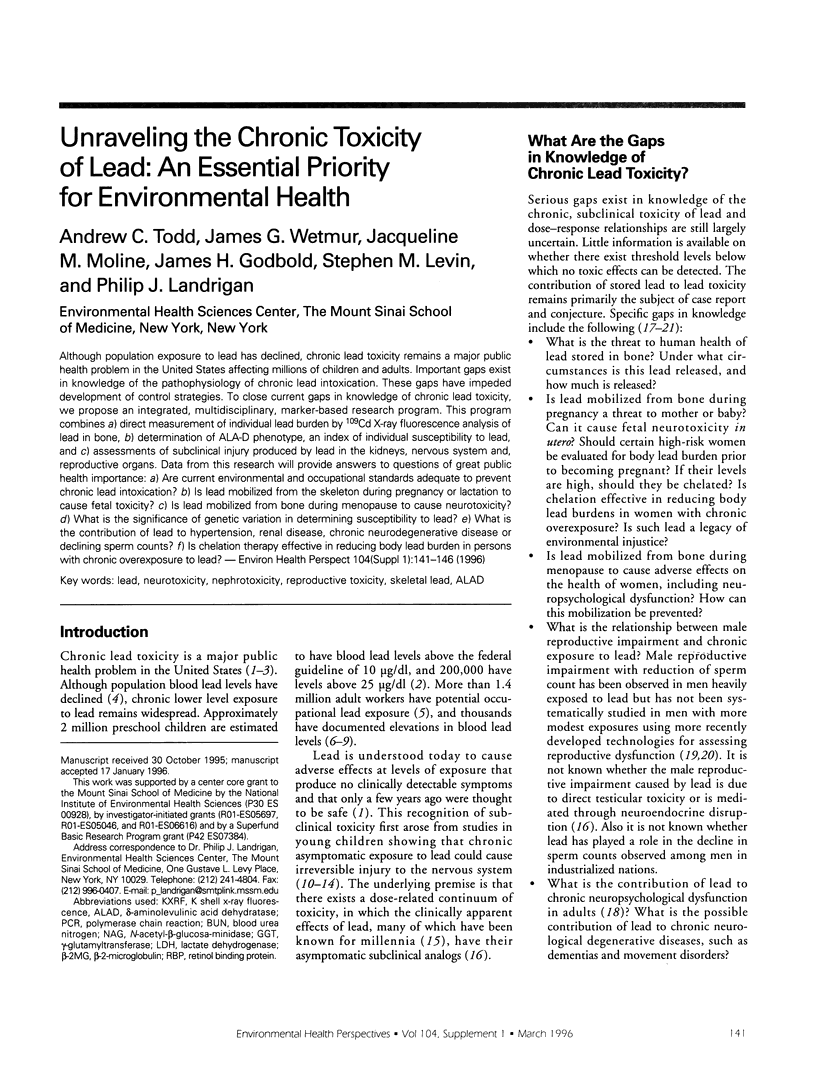
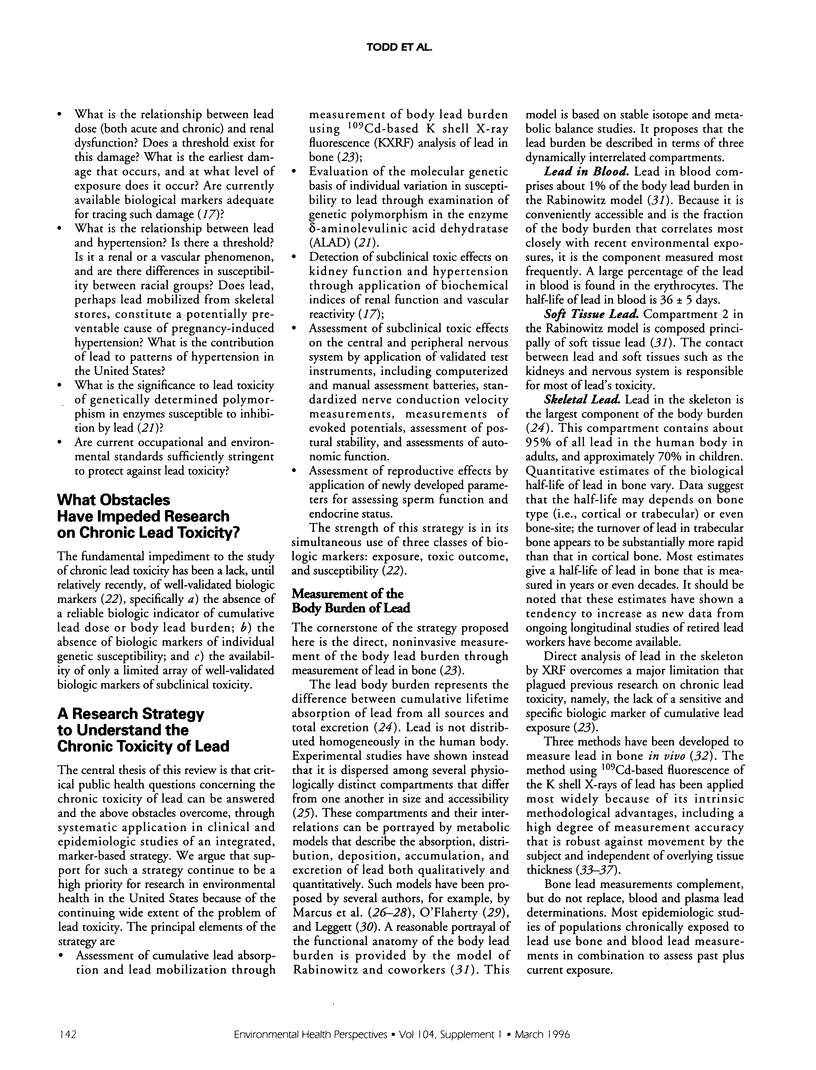
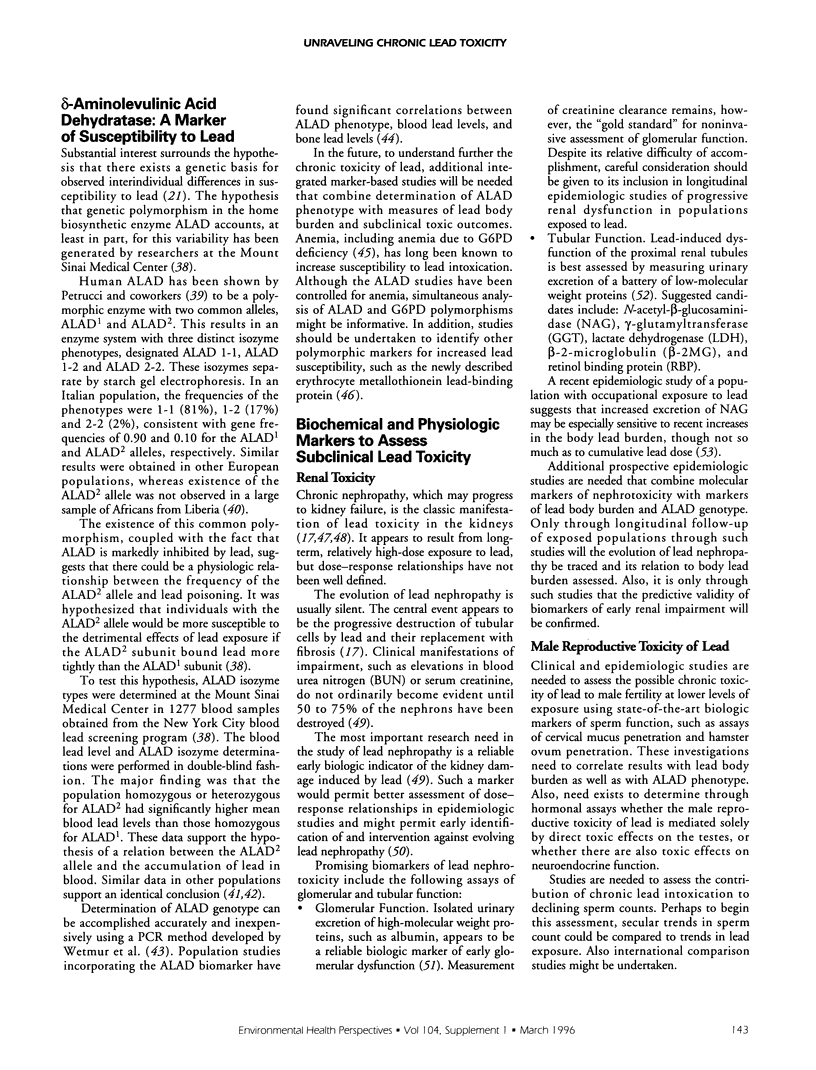

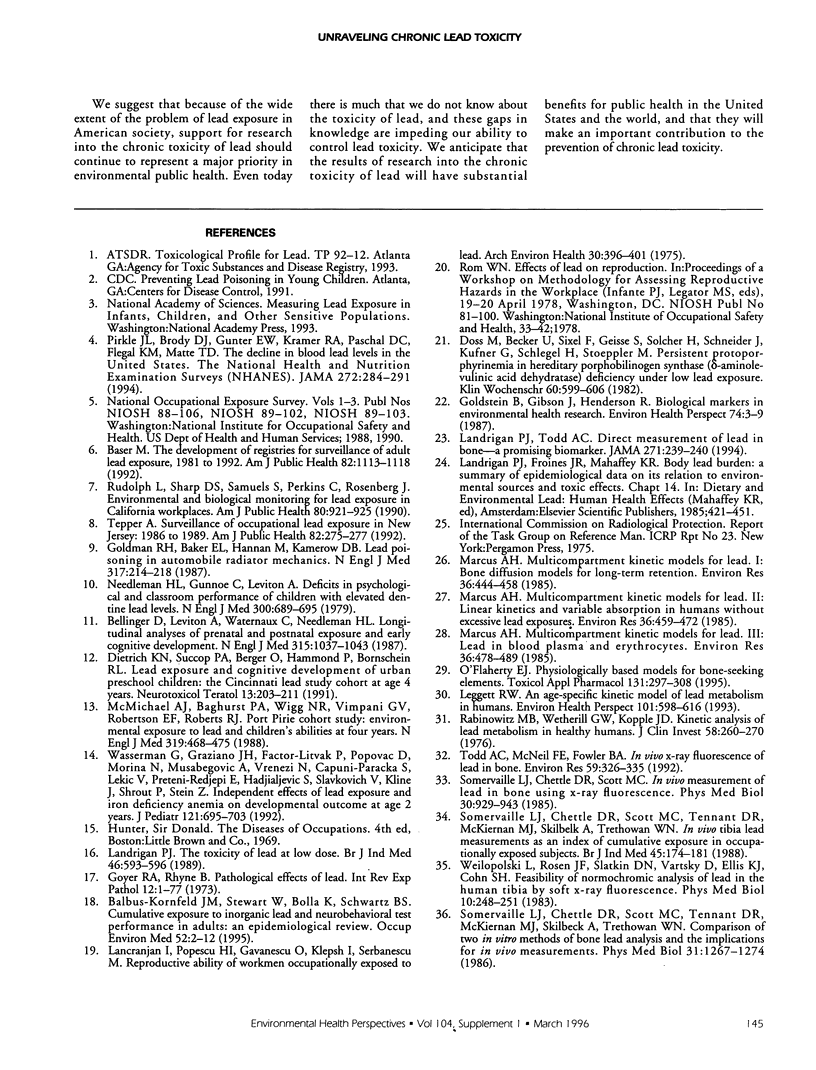
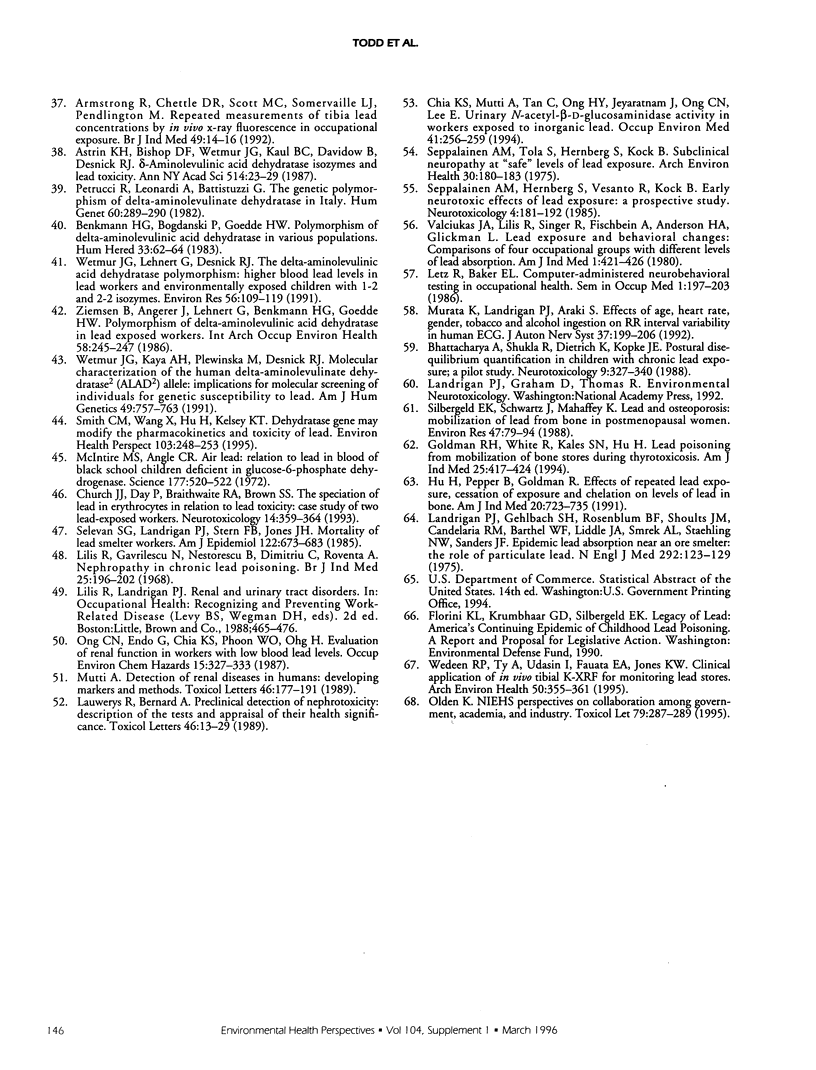
Selected References
These references are in PubMed. This may not be the complete list of references from this article.
- Armstrong R., Chettle D. R., Scott M. C., Somervaille L. J., Pendlington M. Repeated measurements of tibia lead concentrations by in vivo x ray fluorescence in occupational exposure. Br J Ind Med. 1992 Jan;49(1):14–16. doi: 10.1136/oem.49.1.14. [DOI] [PMC free article] [PubMed] [Google Scholar]
- Astrin K. H., Bishop D. F., Wetmur J. G., Kaul B., Davidow B., Desnick R. J. delta-Aminolevulinic acid dehydratase isozymes and lead toxicity. Ann N Y Acad Sci. 1987;514:23–29. doi: 10.1111/j.1749-6632.1987.tb48757.x. [DOI] [PubMed] [Google Scholar]
- Balbus-Kornfeld J. M., Stewart W., Bolla K. I., Schwartz B. S. Cumulative exposure to inorganic lead and neurobehavioural test performance in adults: an epidemiological review. Occup Environ Med. 1995 Jan;52(1):2–12. doi: 10.1136/oem.52.1.2. [DOI] [PMC free article] [PubMed] [Google Scholar]
- Baser M. E. The development of registries for surveillance of adult lead exposure, 1981 to 1992. Am J Public Health. 1992 Aug;82(8):1113–1118. doi: 10.2105/ajph.82.8.1113. [DOI] [PMC free article] [PubMed] [Google Scholar]
- Bellinger D., Leviton A., Waternaux C., Needleman H., Rabinowitz M. Longitudinal analyses of prenatal and postnatal lead exposure and early cognitive development. N Engl J Med. 1987 Apr 23;316(17):1037–1043. doi: 10.1056/NEJM198704233161701. [DOI] [PubMed] [Google Scholar]
- Benkmann H. G., Bogdanski P., Goedde H. W. Polymorphism of delta-aminolevulinic acid dehydratase in various populations. Hum Hered. 1983;33(1):62–64. doi: 10.1159/000153351. [DOI] [PubMed] [Google Scholar]
- Bhattacharya A., Shukla R., Bornschein R., Dietrich K., Kopke J. E. Postural disequilibrium quantification in children with chronic lead exposure: a pilot study. Neurotoxicology. 1988 Fall;9(3):327–340. [PubMed] [Google Scholar]
- Biological markers in environmental health research. Committee on Biological Markers of the National Research Council. Environ Health Perspect. 1987 Oct;74:3–9. doi: 10.1289/ehp.74-1474499. [DOI] [PMC free article] [PubMed] [Google Scholar]
- Church H. J., Day J. P., Braithwaite R. A., Brown S. S. The speciation of lead in erythrocytes in relation to lead toxicity: case studies of two lead-exposed workers. Neurotoxicology. 1993 Summer-Fall;14(2-3):359–364. [PubMed] [Google Scholar]
- Dietrich K. N., Succop P. A., Berger O. G., Hammond P. B., Bornschein R. L. Lead exposure and the cognitive development of urban preschool children: the Cincinnati Lead Study cohort at age 4 years. Neurotoxicol Teratol. 1991 Mar-Apr;13(2):203–211. doi: 10.1016/0892-0362(91)90012-l. [DOI] [PubMed] [Google Scholar]
- Doss M., Becker U., Sixel F., Geisse S., Solcher H., Schneider J., Kufner G., Schlegel H., Stoeppler M. Persistent protoporphyrinemia in hereditary porphobilinogen synthase (delta-aminolevulinic acid dehydrase) deficiency under low lead exposure. A new molecular basis for the pathogenesis of lead intoxication. Klin Wochenschr. 1982 Jun 15;60(12):599–606. doi: 10.1007/BF01711435. [DOI] [PubMed] [Google Scholar]
- Goldman R. H., Baker E. L., Hannan M., Kamerow D. B. Lead poisoning in automobile radiator mechanics. N Engl J Med. 1987 Jul 23;317(4):214–218. doi: 10.1056/NEJM198707233170406. [DOI] [PubMed] [Google Scholar]
- Goldman R. H., White R., Kales S. N., Hu H. Lead poisoning from mobilization of bone stores during thyrotoxicosis. Am J Ind Med. 1994 Mar;25(3):417–424. doi: 10.1002/ajim.4700250309. [DOI] [PubMed] [Google Scholar]
- Goyer R. A., Rhyne B. C. Pathological effects of lead. Int Rev Exp Pathol. 1973;12:1–77. [PubMed] [Google Scholar]
- Hu H., Pepper L., Goldman R. Effect of repeated occupational exposure to lead, cessation of exposure, and chelation on levels of lead in bone. Am J Ind Med. 1991;20(6):723–735. doi: 10.1002/ajim.4700200603. [DOI] [PubMed] [Google Scholar]
- Lancranjan I., Popescu H. I., GAvănescu O., Klepsch I., Serbănescu M. Reproductive ability of workmen occupationally exposed to lead. Arch Environ Health. 1975 Aug;30(8):396–401. doi: 10.1080/00039896.1975.10666733. [DOI] [PubMed] [Google Scholar]
- Landrigan P. J., Gehlbach S. H., Rosenblum B. F., Shoults J. M., Candelaria R. M., Barthel W. F., Liddle J. A., Smrek A. L., Staehling N. W., Sanders J. F. Epidemic lead absorption near an ore smelter. The role of particulate lead. N Engl J Med. 1975 Jan 16;292(3):123–129. doi: 10.1056/NEJM197501162920302. [DOI] [PubMed] [Google Scholar]
- Landrigan P. J., Todd A. C. Direct measurement of lead in bone. A promising biomarker. JAMA. 1994 Jan 19;271(3):239–240. [PubMed] [Google Scholar]
- Landrigan P. J. Toxicity of lead at low dose. Br J Ind Med. 1989 Sep;46(9):593–596. doi: 10.1136/oem.46.9.593. [DOI] [PMC free article] [PubMed] [Google Scholar]
- Lauwerys R., Bernard A. Preclinical detection of nephrotoxicity: description of the tests and appraisal of their health significance. Toxicol Lett. 1989 Mar;46(1-3):13–29. doi: 10.1016/0378-4274(89)90113-6. [DOI] [PubMed] [Google Scholar]
- Leggett R. W. An age-specific kinetic model of lead metabolism in humans. Environ Health Perspect. 1993 Dec;101(7):598–616. doi: 10.1289/ehp.93101598. [DOI] [PMC free article] [PubMed] [Google Scholar]
- Lilis R., Gavrilescu N., Nestorescu B., Dumitriu C., Roventa A. Nephropathy in chronic lead poisoning. Br J Ind Med. 1968 Jul;25(3):196–202. doi: 10.1136/oem.25.3.196. [DOI] [PMC free article] [PubMed] [Google Scholar]
- Marcus A. H. Multicompartment kinetic model for lead. III. Lead in blood plasma and erythrocytes. Environ Res. 1985 Apr;36(2):473–489. doi: 10.1016/0013-9351(85)90039-8. [DOI] [PubMed] [Google Scholar]
- Marcus A. H. Multicompartment kinetic models for lead. I. Bone diffusion models for long-term retention. Environ Res. 1985 Apr;36(2):441–458. doi: 10.1016/0013-9351(85)90037-4. [DOI] [PubMed] [Google Scholar]
- Marcus A. H. Multicompartment kinetic models for lead. II. Linear kinetics and variable absorption in humans without excessive lead exposures. Environ Res. 1985 Apr;36(2):459–472. doi: 10.1016/0013-9351(85)90038-6. [DOI] [PubMed] [Google Scholar]
- McIntire M. S., Angle C. R. Air lead: relation to lead in blood of black school children deficient in glucose-6-phosphate dehydrogenase. Science. 1972 Aug 11;177(4048):520–522. doi: 10.1126/science.177.4048.520. [DOI] [PubMed] [Google Scholar]
- McMichael A. J., Baghurst P. A., Wigg N. R., Vimpani G. V., Robertson E. F., Roberts R. J. Port Pirie Cohort Study: environmental exposure to lead and children's abilities at the age of four years. N Engl J Med. 1988 Aug 25;319(8):468–475. doi: 10.1056/NEJM198808253190803. [DOI] [PubMed] [Google Scholar]
- Murata K., Landrigan P. J., Araki S. Effects of age, heart rate, gender, tobacco and alcohol ingestion on R-R interval variability in human ECG. J Auton Nerv Syst. 1992 Mar;37(3):199–206. doi: 10.1016/0165-1838(92)90041-e. [DOI] [PubMed] [Google Scholar]
- Mutti A. Detection of renal diseases in humans: developing markers and methods. Toxicol Lett. 1989 Mar;46(1-3):177–191. doi: 10.1016/0378-4274(89)90126-4. [DOI] [PubMed] [Google Scholar]
- Needleman H. L., Gunnoe C., Leviton A., Reed R., Peresie H., Maher C., Barrett P. Deficits in psychologic and classroom performance of children with elevated dentine lead levels. N Engl J Med. 1979 Mar 29;300(13):689–695. doi: 10.1056/NEJM197903293001301. [DOI] [PubMed] [Google Scholar]
- O'Flaherty E. J. Physiologically based models for bone-seeking elements. V. Lead absorption and disposition in childhood. Toxicol Appl Pharmacol. 1995 Apr;131(2):297–308. doi: 10.1006/taap.1995.1072. [DOI] [PubMed] [Google Scholar]
- Olden K. NIEHS perspectives on collaboration among government, academia, and industry. Toxicol Lett. 1995 Sep;79(1-3):287–289. doi: 10.1016/0378-4274(95)03379-y. [DOI] [PubMed] [Google Scholar]
- Petrucci R., Leonardi A., Battistuzzi G. The genetic polymorphism of delta-aminolevulinate dehydrase in Italy. Hum Genet. 1982;60(3):289–290. doi: 10.1007/BF00303023. [DOI] [PubMed] [Google Scholar]
- Pirkle J. L., Brody D. J., Gunter E. W., Kramer R. A., Paschal D. C., Flegal K. M., Matte T. D. The decline in blood lead levels in the United States. The National Health and Nutrition Examination Surveys (NHANES) JAMA. 1994 Jul 27;272(4):284–291. [PubMed] [Google Scholar]
- Rabinowitz M. B., Wetherill G. W., Kopple J. D. Kinetic analysis of lead metabolism in healthy humans. J Clin Invest. 1976 Aug;58(2):260–270. doi: 10.1172/JCI108467. [DOI] [PMC free article] [PubMed] [Google Scholar]
- Rudolph L., Sharp D. S., Samuels S., Perkins C., Rosenberg J. Environmental and biological monitoring for lead exposure in California workplaces. Am J Public Health. 1990 Aug;80(8):921–925. doi: 10.2105/ajph.80.8.921. [DOI] [PMC free article] [PubMed] [Google Scholar]
- Selevan S. G., Landrigan P. J., Stern F. B., Jones J. H. Mortality of lead smelter workers. Am J Epidemiol. 1985 Oct;122(4):673–683. doi: 10.1093/oxfordjournals.aje.a114146. [DOI] [PubMed] [Google Scholar]
- Seppäläinen A. M., Hernberg S., Vesanto R., Kock B. Early neurotoxic effects of occupational lead exposure: a prospective study. Neurotoxicology. 1983 Summer;4(2):181–192. [PubMed] [Google Scholar]
- Seppäläinen A. M., Tola S., Hernberg S., Kock B. Subclinical neuropathy at "safe" levels of lead exposure. Arch Environ Health. 1975 Apr;30(4):180–183. doi: 10.1080/00039896.1975.10666672. [DOI] [PubMed] [Google Scholar]
- Silbergeld E. K., Schwartz J., Mahaffey K. Lead and osteoporosis: mobilization of lead from bone in postmenopausal women. Environ Res. 1988 Oct;47(1):79–94. doi: 10.1016/s0013-9351(88)80023-9. [DOI] [PubMed] [Google Scholar]
- Smith C. M., Wang X., Hu H., Kelsey K. T. A polymorphism in the delta-aminolevulinic acid dehydratase gene may modify the pharmacokinetics and toxicity of lead. Environ Health Perspect. 1995 Mar;103(3):248–253. doi: 10.1289/ehp.95103248. [DOI] [PMC free article] [PubMed] [Google Scholar]
- Somervaille L. J., Chettle D. R., Scott M. C., Aufderheide A. C., Wallgren J. E., Wittmers L. E., Jr, Rapp G. R., Jr Comparison of two in vitro methods of bone lead analysis and the implications for in vivo measurements. Phys Med Biol. 1986 Nov;31(11):1267–1274. doi: 10.1088/0031-9155/31/11/008. [DOI] [PubMed] [Google Scholar]
- Somervaille L. J., Chettle D. R., Scott M. C. In vivo measurement of lead in bone using x-ray fluorescence. Phys Med Biol. 1985 Sep;30(9):929–943. doi: 10.1088/0031-9155/30/9/005. [DOI] [PubMed] [Google Scholar]
- Somervaille L. J., Chettle D. R., Scott M. C., Tennant D. R., McKiernan M. J., Skilbeck A., Trethowan W. N. In vivo tibia lead measurements as an index of cumulative exposure in occupationally exposed subjects. Br J Ind Med. 1988 Mar;45(3):174–181. doi: 10.1136/oem.45.3.174. [DOI] [PMC free article] [PubMed] [Google Scholar]
- Tepper A. Surveillance of occupational lead exposure in New Jersey: 1986 to 1989. Am J Public Health. 1992 Feb;82(2):275–277. doi: 10.2105/ajph.82.2.275. [DOI] [PMC free article] [PubMed] [Google Scholar]
- Todd A. C., McNeill F. E., Fowler B. A. In vivo X-ray fluorescence of lead in bone. Environ Res. 1992 Dec;59(2):326–335. doi: 10.1016/s0013-9351(05)80039-8. [DOI] [PubMed] [Google Scholar]
- Valciukas J. A., Lilis R., Singer R., Fischbein A., Anderson H. A., Glickman L. Lead exposure and behavioral changes: comparisons of four occupational groups with different levels of lead absorption. Am J Ind Med. 1980;1(3-4):421–426. doi: 10.1002/ajim.4700010320. [DOI] [PubMed] [Google Scholar]
- Wasserman G., Graziano J. H., Factor-Litvak P., Popovac D., Morina N., Musabegovic A., Vrenezi N., Capuni-Paracka S., Lekic V., Preteni-Redjepi E. Independent effects of lead exposure and iron deficiency anemia on developmental outcome at age 2 years. J Pediatr. 1992 Nov;121(5 Pt 1):695–703. doi: 10.1016/s0022-3476(05)81895-5. [DOI] [PubMed] [Google Scholar]
- Wedeen R. P., Ty A., Udasin I., Favata E. A., Jones K. W. Clinical application of in vivo tibial K-XRF for monitoring lead stores. Arch Environ Health. 1995 Sep-Oct;50(5):355–361. doi: 10.1080/00039896.1995.9935967. [DOI] [PubMed] [Google Scholar]
- Wetmur J. G., Kaya A. H., Plewinska M., Desnick R. J. Molecular characterization of the human delta-aminolevulinate dehydratase 2 (ALAD2) allele: implications for molecular screening of individuals for genetic susceptibility to lead poisoning. Am J Hum Genet. 1991 Oct;49(4):757–763. [PMC free article] [PubMed] [Google Scholar]
- Wetmur J. G., Lehnert G., Desnick R. J. The delta-aminolevulinate dehydratase polymorphism: higher blood lead levels in lead workers and environmentally exposed children with the 1-2 and 2-2 isozymes. Environ Res. 1991 Dec;56(2):109–119. doi: 10.1016/s0013-9351(05)80001-5. [DOI] [PubMed] [Google Scholar]
- Wielopolski L., Rosen J. F., Slatkin D. N., Vartsky D., Ellis K. J., Cohn S. H. Feasibility of noninvasive analysis of lead in the human tibia by soft x-ray fluorescence. Med Phys. 1983 Mar-Apr;10(2):248–251. doi: 10.1118/1.595244. [DOI] [PubMed] [Google Scholar]
- Ziemsen B., Angerer J., Lehnert G., Benkmann H. G., Goedde H. W. Polymorphism of delta-aminolevulinic acid dehydratase in lead-exposed workers. Int Arch Occup Environ Health. 1986;58(3):245–247. doi: 10.1007/BF00432107. [DOI] [PubMed] [Google Scholar]


